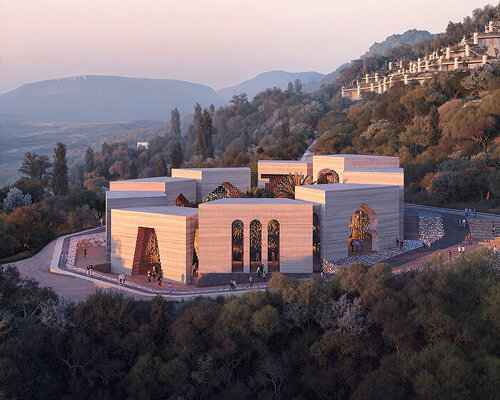faith park: A Landscape of Shared Origins
Bjarke Ingels Group has been selected to design Faith Park, a 200,000-square-meter public park planned for the hillsides outside Tirana, Albania. Conceived as a landscape of coexistence, the masterplan brings together architecture, landscape, and spirituality in a single continuous terrain that connects the valley floor to the mountain’s crest.
The design unfolds as a ‘genealogical tree of faith,’ with pathways that diverge from a shared point in the valley and ascend through gardens, olive groves, and forested slopes. Along these routes, nine pavilions appear within the terrain, each devoted to a distinct spiritual tradition. Their placement and form follow the natural contours of the hillside and create a spatial rhythm that alternates between enclosure and openness, or reflection and movement.
At the entrance to the park, the Museum of Remembrance gathers nine rammed-earth volumes around a central garden. The material’s earthen texture sets the tone for the experience centered on the physical presence of the land itself.
Bjarke Ingels Group to design Faith Park on the hillsides outside Tirana | visualizations © Beauty and the Bit
bjarke ingels group’s symbolic Material palette
Each pavilion of Tirana’s Faith Park is designed by the architects at Bjarke Ingels Group to be constructed in a material that draws on the geographic and cultural lineage of the tradition it represents: Jerusalem limestone for Judaism, colored Italian marble for Christianity, white sandstone mosaic for Islam, and an array of granite, onyx, marble, and river-polished stone for the Dharmic and East Asian traditions.
As visitors progress through the park, the sequence of materials becomes a tactile archive, with each surface holding its own weight and color.
The architecture does not interrupt the landscape. Instead, it appears to grow out of it, merging built form and terrain into a single field. Gardens and paths are arranged to follow natural gradients, while native vegetation like olive, cypress, and pine emphasizes the site as part of a Mediterranean context.
nine pavilions dedicated to different spiritual traditions emerge along the sloping terrain
design for a growing tirana
Bjarke Ingels Group’s Faith Park joins a series of ambitious public projects in Tirana, and throughout Albania beyond. Over the past decade, the country has undergone a gradual transformation led by international and local architects alike, from Archi-Tectonics’ Festival City, Oppenheim Architecture’s colorful Vlore Beach Urban Development, Studio Libeskind’s Magnet Residence, and Bofill Taller de Arquitectura’s Red Sol Resort.
Extending this approach into the highlands, the project embraces the landscape as a civic realm rather than a boundary. BIG, together with a team comprising SON Architects and Edoardo Tresoldi, designs the park to welcome visitors of all backgrounds, bringing spaces for walking and gathering.
Bjarke Ingels describes the project as ‘a livable, inhabitable evolutionary tree of faith mapped onto the natural topography of a mountain, connecting the valley to the summit, the earth to the heavens, and rooted in respect for nature.’ The statement reflects a design philosophy that views ecological awareness as an essential form of reverence.
each pavilion is built from materials that reflect its faith and geographic origin
the Museum of Remembrance marks the entrance with nine rammed-earth volumes surrounding a garden
paths and vegetation follow the natural contours of the Albanian hillside
the 200,000 square meter landscape connects the valley to the mountain crest
project info:
name: Faith Park
architect: Bjarke Ingels Group (BIG) | @big_builds
location: Tirana, Albania
visualizations: © Beauty and the Bit | @thisisbtb
The post bjarke ingels group to scatter symbolic stone pavilions across tirana hillside appeared first on designboom | architecture & design magazine.

